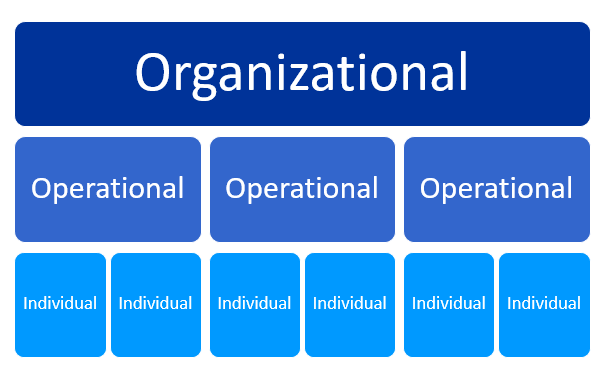Three Levels of Organizational Performance
Measuring and managing organizational performance as well as improving performance in business can be viewed and analyzed on three different levels.
These levels are:
- Organizational Level
- Operational Level
- Individual Level
To optimize performance, organizations need to improve all three levels of performance. However, one of the biggest challenges for performance management is the integration of these three different aspects of organizational performance. All three of these levels of performance have their own functions and set of activities, but are linked to each other. This linkage is to ensure all organizational activities at every level are streamlined and leveraged into a unified direction. Without linking these levels to ensure they are in sync, performance inefficiencies occur at every level. Linking these levels not only improves overall performance, but will help achieve the overall strategic goals and objectives for the organization.
Overview of the Three Levels of Organizational Performance
Organizational Level
The organizational level deals with the organization as a whole. It is the framework of the organization. At this level, the focus is on strategic management activities – its strategy, structure, design, overall goals, and mission.
Operational Level
The operational level deals with the daily processes of the organization. It is the functional areas of the organization – sales, production, customer service, finance, and human resources. At this level, the focus is on quality management and process improvement – its processes and workflows.
Individual Level
The individual level deals with the job performer. At this level, the focus is on performance management and human resource management – its employee’s skills and knowledge as well as rewards and recognition systems.

Three Levels of Organizational Performance Explained
The Organizational Level
The organizational level is the strategic level. This is the highest level of organizational performance. This is where management deals with strategy, design, structure, policy, and deployment of resources.
Strategic management is what drives performance at this level. It involves such topics as organizational structure, culture, inter-organizational cooperation, change management, technology, and external environmental forces.
Strategic management should define the organization’s mission and purpose. It should also direct all downstream decision making to the lower two levels. This downward stream helps ensure linkage between the three levels.
The organizational level involves:
- strategy
- design
- structure
- corporate policy
- resource deployment
The Operational Level
The operational level is the quality management and process improvement level. This is where the focus is on workflow and process.
At the operational level, the focus is on the achievement of departmental and operational objectives. Although these objectives are aligned with the organization’s strategy, the emphasis here is more functional and tactical. The operational performance is evaluated in terms of efficiency and effectiveness.
The operational level involves:
- workflow
- process improvement
- quality controls
- department and job design
- reengineering interventions
The Individual Level
The individual level is the performance management level. This is where management looks at the performance of individuals in an organizational context. It focuses on skills, knowledge, rewards, recognition, coaching, and training interventions.
At the individual level, performance management is represented by an integrated system for continuously improving the performance of all employees. It measures how each employee is performing relative to others within the organizations. If training and development interventions are need, they can be deployed either on an individual or department level basis.
The individual level involves:
- defining work goals and standards
- rewards and recognition
- training and development
- coaching and mentoring

Links
